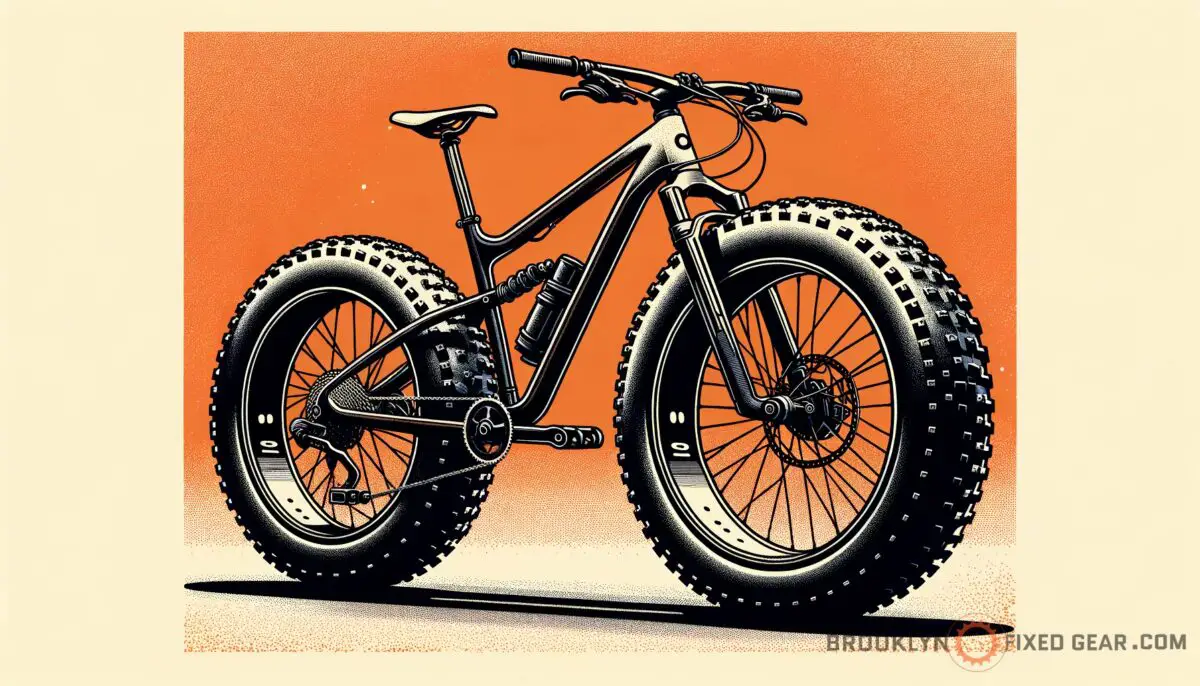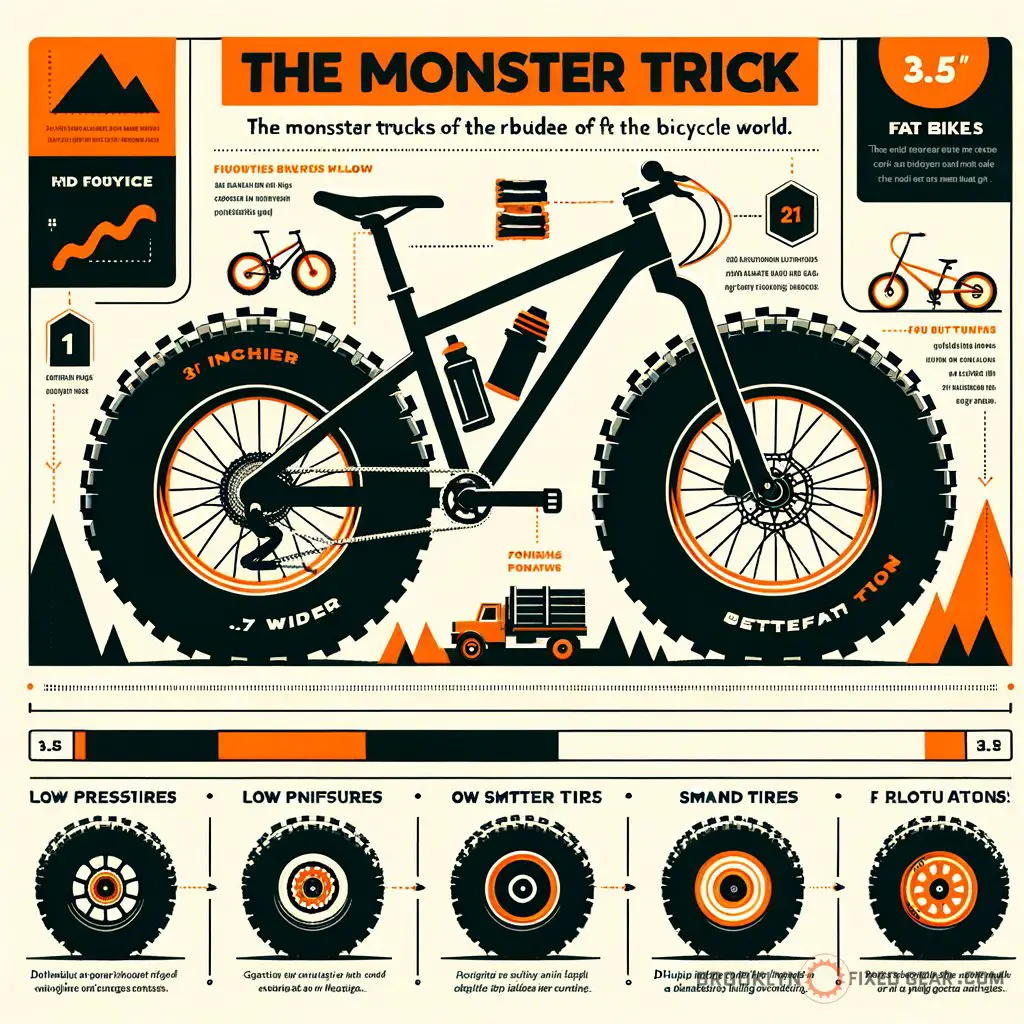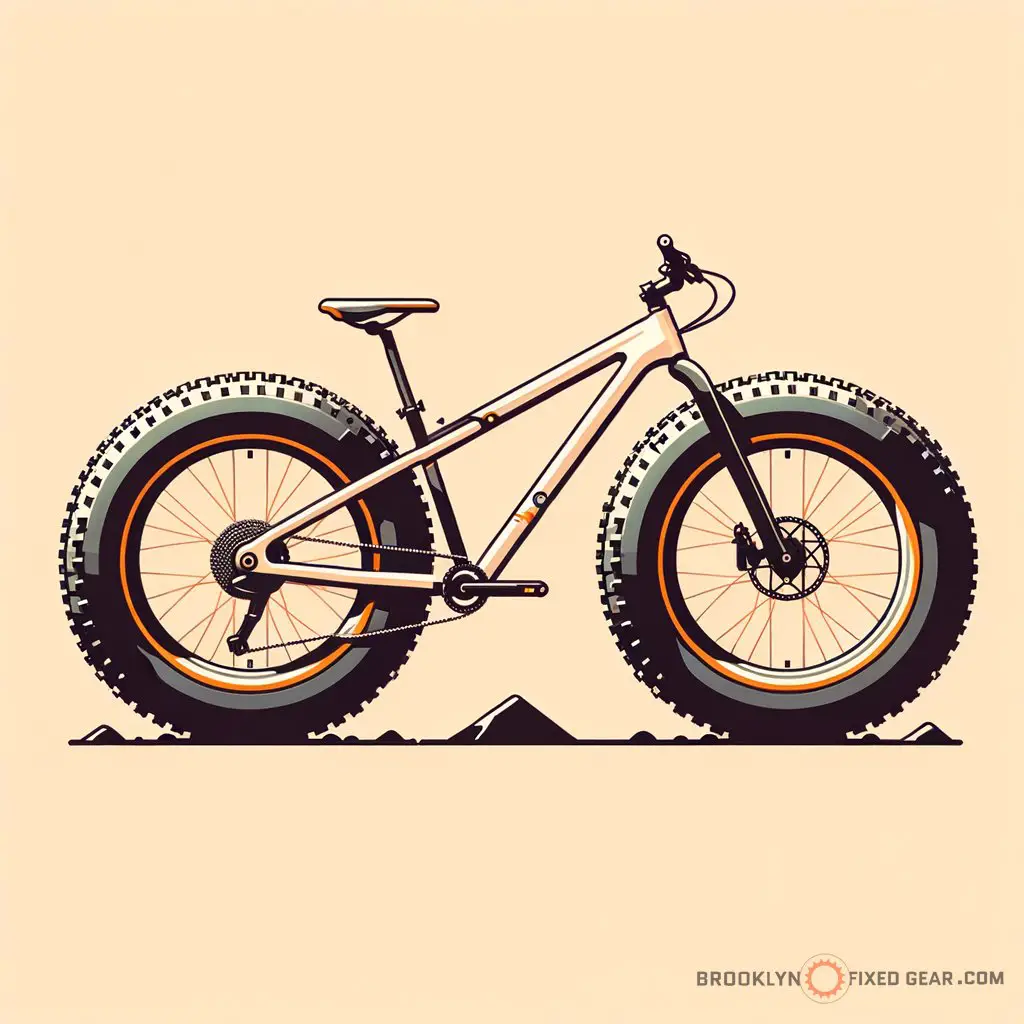Have you ever wondered about those chunky tire bikes you’ve seen on the snow or sand and thought, “what’s the deal with those?” Well, you’re not alone in your curiosity. Dive into the world of fat bikes and discover why they stand out in the cycling community. We’ll cover the essentials and explore some intriguing facets of fat tire bikes.
Ready to uncover what makes a fat bike tick? Check out the best fixie bikes to see the difference.
Key takeaways
- Wide tires and low pressure are the hallmarks of a fat bike’s design, making them suitable for challenging terrains.
- Maintenance and customization are key for keeping your fat bike in great shape and tailored to your adventures.
- Fat bikes have unique uses and are increasingly popular for adventurous riders seeking off-the-beaten-path experiences.
What is a fat bike
Fat bikes are like the monster trucks of the bicycle world. With their oversized tires, typically 3.7″ or wider, they’re built to conquer terrain that would leave other bikes struggling. Generally, these tires are run at low pressures, which allows them to distribute a rider’s weight over a broader area.

This floatation helps them roll over snow, sand, and other challenging conditions with ease.
Here’s a quick breakdown of some key characteristics:
- Wide tires for better traction – The width creates a larger contact patch with the ground.
- Low tire pressure – Enhances comfort and grip on uneven surfaces.
- Understand the basic bike anatomy at what are dropouts.
Innovation doesn’t stop at the tires; fat bikes also sport frames with extra clearance to accommodate their hefty wheels. Plus, the gearing on these workhorses is tweaked to allow for easier pedaling in rough conditions. High-rise handlebars promote an upright riding stance, ideal for stability when the going gets tough.
For a closer look at other bike types and their features, you might want to learn about what Dura-Ace means in the context of cycling.
Opinion time: let’s be straight—fat bikes are an odd bunch. They’re the quirky cousin at the bike family reunion, and I’ll admit, they’re not my go-to. However, I can’t deny that they offer a unique ride.
A friend once told me how they plowed through a snowdrift with ease on one of these beasts. If agility and speed are your jam, stick to track bikes or a zap around on a fixie. Still, if you’re aiming for some off-beat adventure, give these wide-wheeled wonders a spin.
They’re perfect for when the trail gets more “wilderness” and less “tarmac.”
Imagine a scene straight out of an arctic expedition movie, where the protagonist deftly navigates the snowy tundra on — yep, you guessed it — a fat bike. It’s a testament to their go-anywhere attitude. Just like that movie hero, these bikes face the unrideable and simply roll over it.
Curious to know about endurance bikes and how they stack up? Check out what is an endurance bike for more info.
State Bicycle Co. Black Label 6061

State Bicycle Co. Black Label 6061
Essentials of fat bikes
What defines a fat bike
Fat bikes are defined by their large, wide tires, typically 3.8 inches or more in width, mounted on rims wider than 2.6 inches. These bikes are specifically designed to navigate through unstable terrain, such as sand, snow, or mud, where standard bikes would falter. The low tire pressure allows for a smoother ride over bumps and enhances the grip on slippery surfaces.

If you’re curious about gearing up, explore the best bike multi-tools for any adjustments you might need on the go.
The design and technology of fat bikes
Fat bikes showcase specific design features to support the functionality of their wide tires, including wider forks and chainstays to accommodate the increased tire width. This extra space prevents mud and snow from building up. The frame geometry is usually relaxed, offering a comfortable, upright riding position.
To understand more about tech advancements in cycling, take a look at what does electronic shifting mean.
Usage and versatility
Ideal conditions for fat biking
The best conditions for fat biking are those where traditional bikes struggle. This includes snowy trails, sandy beaches, and loose gravel paths. The flotation provided by the wide tires makes fat bikes suitable for all-season use.
It’s a cycle category growing in popularity among adventure riders and those living in snowy regions. For a read on a different cycling discipline, dive into what is enduro cycling.
Fat bikes in the cycling community
Despite not being a traditional choice for most cyclists, fat bikes have carved out their niche. They’re appreciated for their ability to tackle terrains that are inaccessible to the average mountain or road bike. It has led to a dedicated community of fat bikers who enjoy the unique challenges and adventures these bikes facilitate.
For insights on bike setup and posture, check out what is ergonomics in cycling.
Maintenance and care
Keeping a fat bike in top shape
Regular maintenance of a fat bike is similar to that of other bikes, with a focus on cleaning and lubricating the chain, checking tire pressure, and ensuring that bolts and moving parts are secure. The distinctive factor is the need to clean the wide tires and rims, which can collect more debris due to their size. Discover common mistakes made when building a fixie to avoid similar errors with your fat bike.
Customizing and upgrading
Fat bike enthusiasts usually enjoy customizing their rides. Options for customization include changing out the saddle for comfort on longer rides, or the handlebars for better control and ergonomics. For more on choosing the right bike saddle, consider how to choose a bike saddle as your guide.
We’ll provide a hypothetical data table next — remember that the table below will not contain real data but is an example of how a data table on the topic might look.
Leading paragraph summarizing the table:
Below is a data table highlight the types of terrain suitable for fat bikes compared to traditional mountain and road bikes. The purpose is to showcase the versatility and specific niche that fat bikes fill in the cycling world.
| Terrain Type | Fat Bike Suitability | Mountain Bike Suitability | Road Bike Suitability |
|---|---|---|---|
| Snowy Trails | Excellent | Fair | Poor |
| Sandy Beaches | Excellent | Fair | Poor |
| Loose Gravel | Good | Good | Fair |
| Paved Roads | Fair | Excellent | Excellent |
| Rocky Paths | Good | Excellent | Poor |
“Fat bikes are like the monster trucks of the bicycle world; their oversized tires are built to conquer terrain that would leave other bikes struggling. They tackle the unrideable and simply roll over it.”
Navigating the world of fat bikes requires knowing what to embrace and what to sidestep. Here’s a quick guide to the dos and don’ts, ensuring you make the most out of your fat biking experience.
| Do | Don’t |
|---|---|
| Keep your tire pressure low for traction | Overinflate tires which reduces stability |
| Use wide pedals to support larger boots | Neglect post-ride maintenance in sloppy conditions |
| Consider frame bags for gear storage | Assume all bike racks fit fat bike tires |
| Opt for hydraulic disc brakes for better stopping power | Skimp on lighting if you’re riding in low visibility conditions |

More fat biking tips
When setting out on a fat bike adventure, there’s always something new to learn that can enhance your ride. Beyond the basics, these nuggets of wisdom might come in handy:
- Start with the right gear: Appropriate clothing can make or break your ride, so dress in layers and prepare for changing conditions.
- Adjust your riding style: Fat bikes handle differently. Learn to let the bike float and avoid fighting the terrain.
- Experiment with tire pressure: The perfect pressure depends on the conditions, so don’t be afraid to tweak it.
- Master the art of balance: With the added stability of wide tires, use your body weight to enhance maneuverability.
- Stay hydrated and energized: Larger tires mean more rolling resistance, so keep water and snacks handy to keep your energy up.
- Safety first: Even on a fat bike, helmets and protective gear are crucial. Stay secure out there!
- Understand your bike’s capabilities: Your fat bike can go a lot of places, but that doesn’t mean it should go everywhere. Be mindful of the limits.
If you are a visual learner, check out this video titled ‘Fatbike 101: Everything you need to know!’
Frequently asked questions (FAQ)
Can fat bikes be used for racing?
Yes, fat bikes can be raced, especially in events specifically designed for them, such as winter races on snow or endurance challenges on sand. They may not be as fast as traditional racing bikes on pavement, but they excel in conditions where other bikes can’t compete.
How do you store a fat bike when not in use?
Storing a fat bike isn’t too different from storing other bicycles. Ensure it’s in a clean, dry area, preferably hung by the frame or wheels to save space and protect the tires from flat spots. Using a bike cover can also protect it from dust and moisture.
Are fat bikes more difficult to pedal?
Due to larger, heavier tires and increased rolling resistance, fat bikes can be more challenging to pedal on hard-packed surfaces. However, their efficiency and ease come into play on soft terrain where traditional bikes would not be able to progress at all.
Final thoughts
As we journey through the diverse terrain of cycling disciplines, fat bikes stand out as the trailblazing juggernauts capable of making the impassable accessible. They may not be the traditional pick for a cyclist, especially for someone like myself who swears by the agility and simplicity of fixed-gear bikes. Yet, there’s no denying that fat bikes open up a world of adventure and challenge.
So, whether it’s the call of the wild or the thrill of trying something new, consider what these rugged rides have to offer.
What kind of wild adventures would you embark on with a fat bike? Did I cover everything you wanted to know? Let me know in the comments section below.
I read and reply to every comment. If you found this article helpful, share it with a friend, and check out my full blog for more tips and tricks on cycling culture and maintenance. Thanks for reading, and keep pedaling towards your next great ride!















